Statistical Analysis and Hypothesis Testing Assignment Solution
VerifiedAdded on 2020/10/23
|7
|1454
|112
Homework Assignment
AI Summary
This document presents a complete solution to a hypothesis testing assignment, covering various aspects of statistical analysis. The solution begins with calculating descriptive statistics, including mean and standard deviation, for investment data, followed by the interpretation of these values. It then addresses the calculation of 95% confidence limits for overdue accounts, providing a step-by-step approach to determine the range within which the average amount outstanding falls. The assignment further explores the importance of hypothesis testing, discussing its role in evaluating variables, identifying relationships, and finding potential errors. The document also delves into qualitative data analysis, recommending content analysis as a suitable method and outlining techniques like conceptualization, coding, and categorization, along with their advantages and drawbacks. Finally, the solution includes a set of relevant questions that could be used to gather data and insights. The assignment provides a comprehensive overview of hypothesis testing, statistical analysis, and qualitative data analysis techniques.
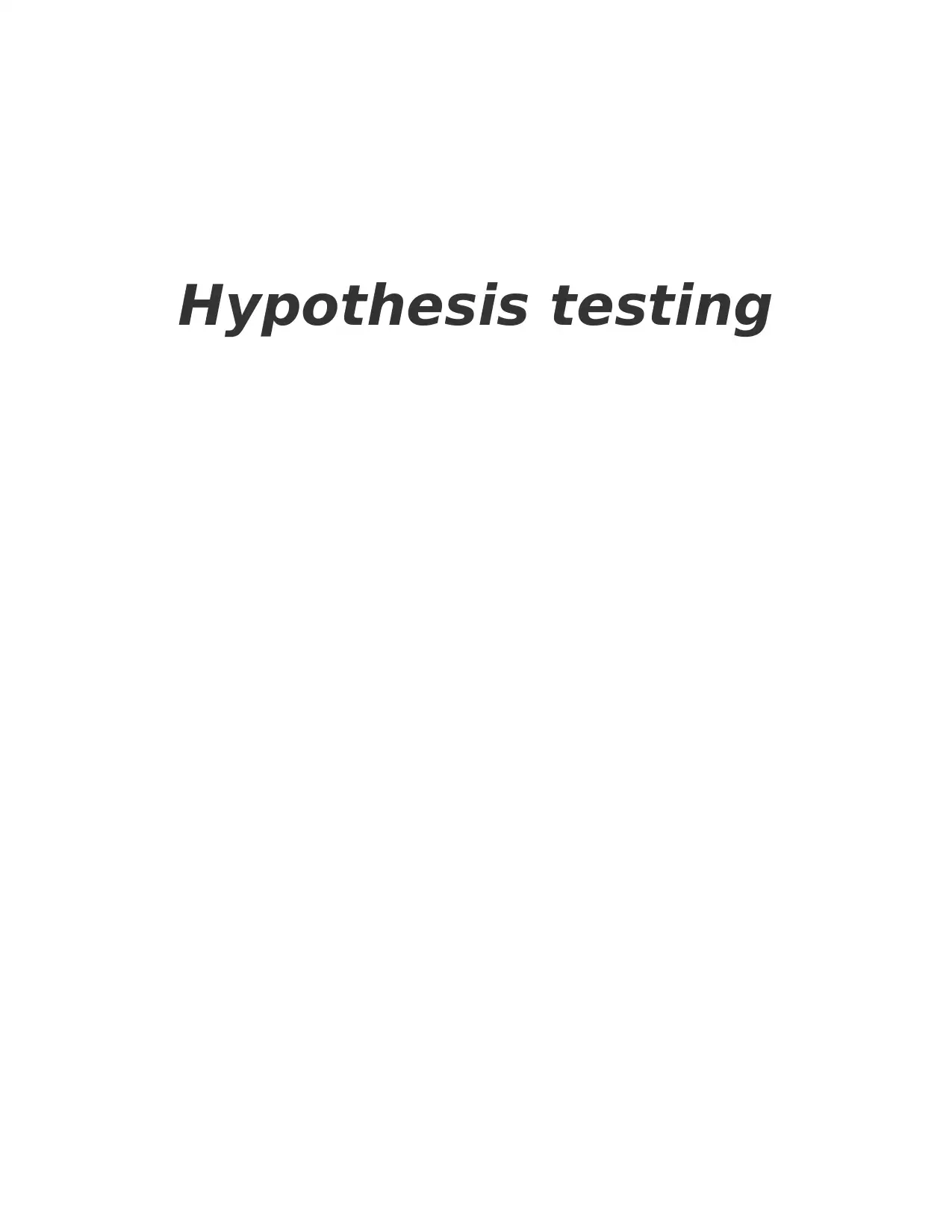
Hypothesis testing
Paraphrase This Document
Need a fresh take? Get an instant paraphrase of this document with our AI Paraphraser
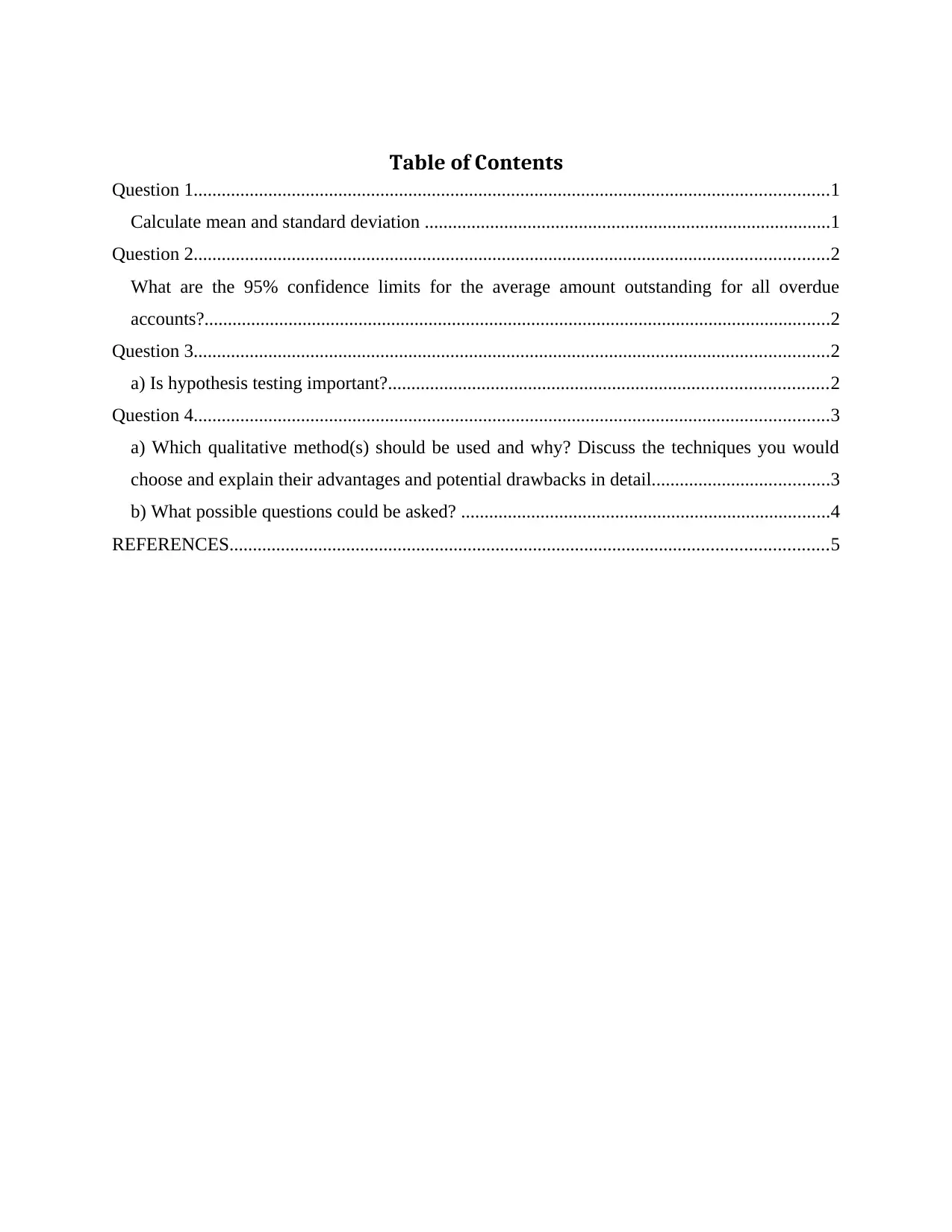
Table of Contents
Question 1........................................................................................................................................1
Calculate mean and standard deviation .......................................................................................1
Question 2........................................................................................................................................2
What are the 95% confidence limits for the average amount outstanding for all overdue
accounts?......................................................................................................................................2
Question 3........................................................................................................................................2
a) Is hypothesis testing important?..............................................................................................2
Question 4........................................................................................................................................3
a) Which qualitative method(s) should be used and why? Discuss the techniques you would
choose and explain their advantages and potential drawbacks in detail......................................3
b) What possible questions could be asked? ...............................................................................4
REFERENCES................................................................................................................................5
Question 1........................................................................................................................................1
Calculate mean and standard deviation .......................................................................................1
Question 2........................................................................................................................................2
What are the 95% confidence limits for the average amount outstanding for all overdue
accounts?......................................................................................................................................2
Question 3........................................................................................................................................2
a) Is hypothesis testing important?..............................................................................................2
Question 4........................................................................................................................................3
a) Which qualitative method(s) should be used and why? Discuss the techniques you would
choose and explain their advantages and potential drawbacks in detail......................................3
b) What possible questions could be asked? ...............................................................................4
REFERENCES................................................................................................................................5

Question 1
Calculate mean and standard deviation
Descriptive Statistics
N Range Minimum Maximum Mean Std. Deviation Variance
investmentA 16 14.00 72.00 86.00 78.6875 4.45300 19.829
investmentB 16 23.00 75.00 98.00 87.5625 6.76233 45.729
Valid N (listwise) 16
T-TEST
/TESTVAL=0
/MISSING=ANALYSIS
/VARIABLES=investmentA investmentB
/CRITERIA=CI(.95).
Interpretation – From above table it can be analyzed that the mean value of investment A is
78.68 and its standard deviation is 4.45. On other hand, mean value of investment B is 87.56 and
its standard deviation is 6.76. Thus, it can be concluded that investment B average return is more
as compared to A in every quarter. Along with this, the standard deviation of investment B is
more as compared to A. This means that there is more difference in different quarter oin
investment B.
One-Sample Statistics
N Mean Std. Deviation Std. Error Mean
investmentA 16 78.6875 4.45300 1.11325
investmentB 16 87.5625 6.76233 1.69058
One-Sample Test
Test Value = 0
t df Sig. (2-tailed) Mean Difference 95% Confidence Interval of the
Difference
Lower Upper
investmentA 70.683 15 .000 78.68750 76.3147 81.0603
investmentB 51.794 15 .000 87.56250 83.9591 91.1659
1
Calculate mean and standard deviation
Descriptive Statistics
N Range Minimum Maximum Mean Std. Deviation Variance
investmentA 16 14.00 72.00 86.00 78.6875 4.45300 19.829
investmentB 16 23.00 75.00 98.00 87.5625 6.76233 45.729
Valid N (listwise) 16
T-TEST
/TESTVAL=0
/MISSING=ANALYSIS
/VARIABLES=investmentA investmentB
/CRITERIA=CI(.95).
Interpretation – From above table it can be analyzed that the mean value of investment A is
78.68 and its standard deviation is 4.45. On other hand, mean value of investment B is 87.56 and
its standard deviation is 6.76. Thus, it can be concluded that investment B average return is more
as compared to A in every quarter. Along with this, the standard deviation of investment B is
more as compared to A. This means that there is more difference in different quarter oin
investment B.
One-Sample Statistics
N Mean Std. Deviation Std. Error Mean
investmentA 16 78.6875 4.45300 1.11325
investmentB 16 87.5625 6.76233 1.69058
One-Sample Test
Test Value = 0
t df Sig. (2-tailed) Mean Difference 95% Confidence Interval of the
Difference
Lower Upper
investmentA 70.683 15 .000 78.68750 76.3147 81.0603
investmentB 51.794 15 .000 87.56250 83.9591 91.1659
1
⊘ This is a preview!⊘
Do you want full access?
Subscribe today to unlock all pages.

Trusted by 1+ million students worldwide
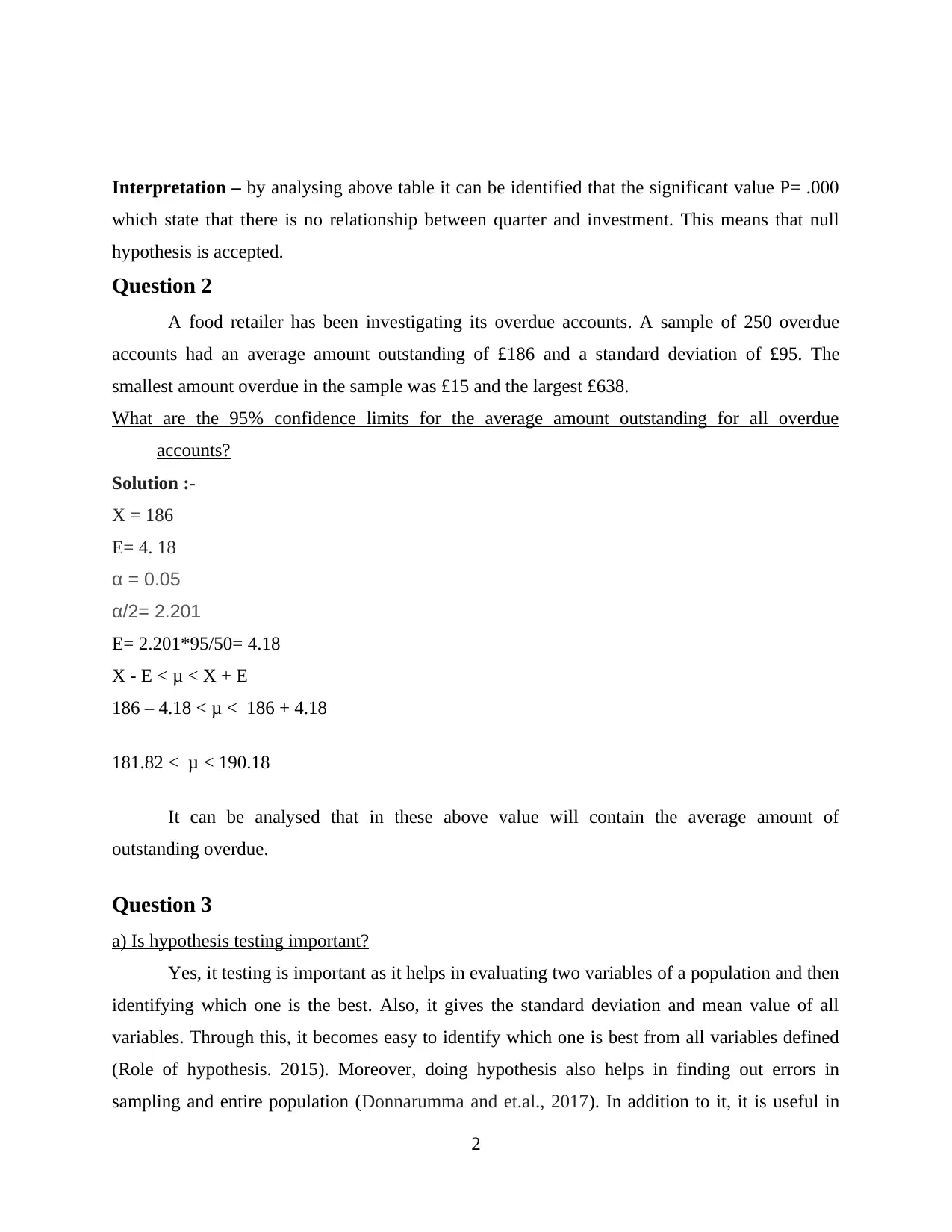
Interpretation – by analysing above table it can be identified that the significant value P= .000
which state that there is no relationship between quarter and investment. This means that null
hypothesis is accepted.
Question 2
A food retailer has been investigating its overdue accounts. A sample of 250 overdue
accounts had an average amount outstanding of £186 and a standard deviation of £95. The
smallest amount overdue in the sample was £15 and the largest £638.
What are the 95% confidence limits for the average amount outstanding for all overdue
accounts?
Solution :-
X = 186
E= 4. 18
α = 0.05
α/2= 2.201
E= 2.201*95/50= 4.18
X - E < μ < X + E
186 – 4.18 < μ < 186 + 4.18
181.82 < μ < 190.18
It can be analysed that in these above value will contain the average amount of
outstanding overdue.
Question 3
a) Is hypothesis testing important?
Yes, it testing is important as it helps in evaluating two variables of a population and then
identifying which one is the best. Also, it gives the standard deviation and mean value of all
variables. Through this, it becomes easy to identify which one is best from all variables defined
(Role of hypothesis. 2015). Moreover, doing hypothesis also helps in finding out errors in
sampling and entire population (Donnarumma and et.al., 2017). In addition to it, it is useful in
2
which state that there is no relationship between quarter and investment. This means that null
hypothesis is accepted.
Question 2
A food retailer has been investigating its overdue accounts. A sample of 250 overdue
accounts had an average amount outstanding of £186 and a standard deviation of £95. The
smallest amount overdue in the sample was £15 and the largest £638.
What are the 95% confidence limits for the average amount outstanding for all overdue
accounts?
Solution :-
X = 186
E= 4. 18
α = 0.05
α/2= 2.201
E= 2.201*95/50= 4.18
X - E < μ < X + E
186 – 4.18 < μ < 186 + 4.18
181.82 < μ < 190.18
It can be analysed that in these above value will contain the average amount of
outstanding overdue.
Question 3
a) Is hypothesis testing important?
Yes, it testing is important as it helps in evaluating two variables of a population and then
identifying which one is the best. Also, it gives the standard deviation and mean value of all
variables. Through this, it becomes easy to identify which one is best from all variables defined
(Role of hypothesis. 2015). Moreover, doing hypothesis also helps in finding out errors in
sampling and entire population (Donnarumma and et.al., 2017). In addition to it, it is useful in
2
Paraphrase This Document
Need a fresh take? Get an instant paraphrase of this document with our AI Paraphraser
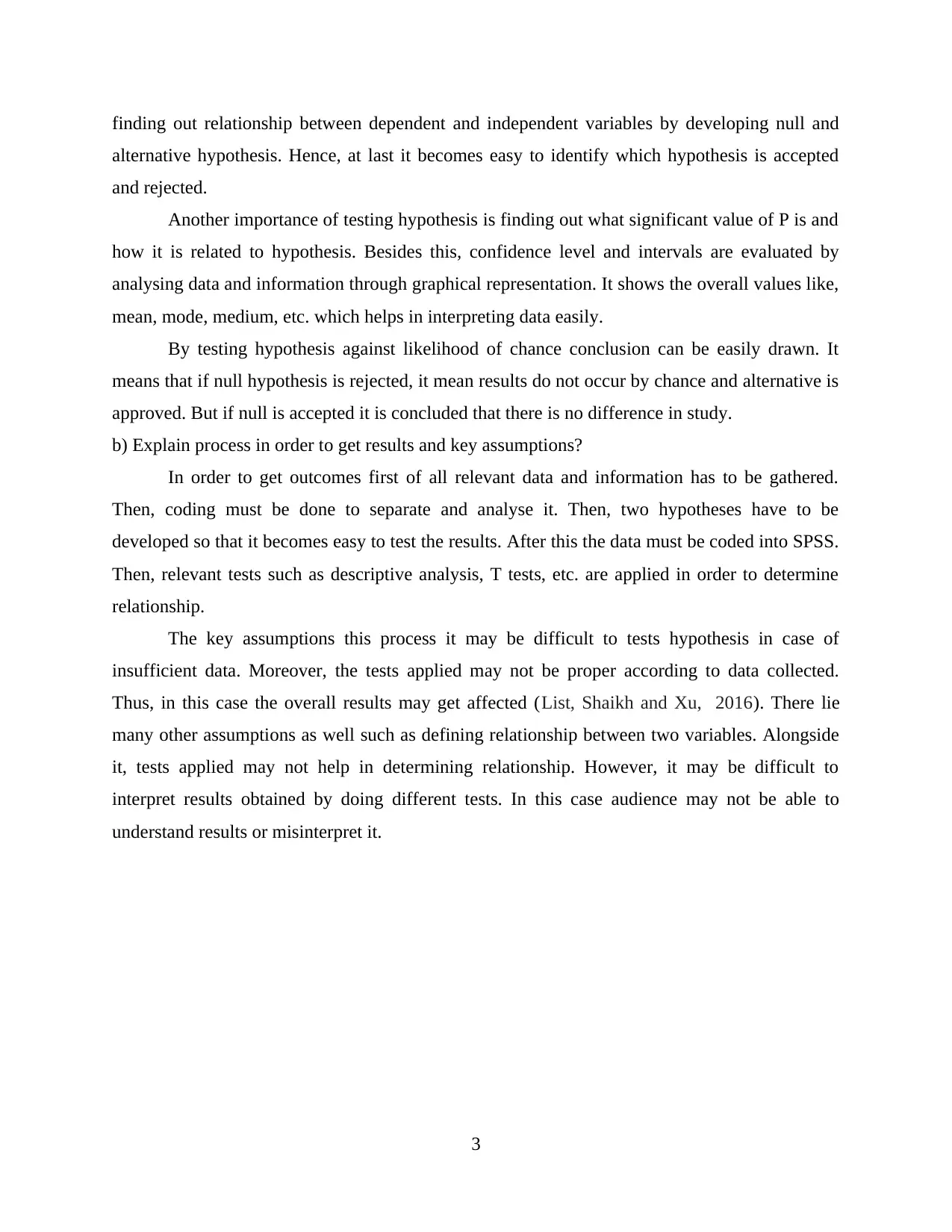
finding out relationship between dependent and independent variables by developing null and
alternative hypothesis. Hence, at last it becomes easy to identify which hypothesis is accepted
and rejected.
Another importance of testing hypothesis is finding out what significant value of P is and
how it is related to hypothesis. Besides this, confidence level and intervals are evaluated by
analysing data and information through graphical representation. It shows the overall values like,
mean, mode, medium, etc. which helps in interpreting data easily.
By testing hypothesis against likelihood of chance conclusion can be easily drawn. It
means that if null hypothesis is rejected, it mean results do not occur by chance and alternative is
approved. But if null is accepted it is concluded that there is no difference in study.
b) Explain process in order to get results and key assumptions?
In order to get outcomes first of all relevant data and information has to be gathered.
Then, coding must be done to separate and analyse it. Then, two hypotheses have to be
developed so that it becomes easy to test the results. After this the data must be coded into SPSS.
Then, relevant tests such as descriptive analysis, T tests, etc. are applied in order to determine
relationship.
The key assumptions this process it may be difficult to tests hypothesis in case of
insufficient data. Moreover, the tests applied may not be proper according to data collected.
Thus, in this case the overall results may get affected (List, Shaikh and Xu, 2016). There lie
many other assumptions as well such as defining relationship between two variables. Alongside
it, tests applied may not help in determining relationship. However, it may be difficult to
interpret results obtained by doing different tests. In this case audience may not be able to
understand results or misinterpret it.
3
alternative hypothesis. Hence, at last it becomes easy to identify which hypothesis is accepted
and rejected.
Another importance of testing hypothesis is finding out what significant value of P is and
how it is related to hypothesis. Besides this, confidence level and intervals are evaluated by
analysing data and information through graphical representation. It shows the overall values like,
mean, mode, medium, etc. which helps in interpreting data easily.
By testing hypothesis against likelihood of chance conclusion can be easily drawn. It
means that if null hypothesis is rejected, it mean results do not occur by chance and alternative is
approved. But if null is accepted it is concluded that there is no difference in study.
b) Explain process in order to get results and key assumptions?
In order to get outcomes first of all relevant data and information has to be gathered.
Then, coding must be done to separate and analyse it. Then, two hypotheses have to be
developed so that it becomes easy to test the results. After this the data must be coded into SPSS.
Then, relevant tests such as descriptive analysis, T tests, etc. are applied in order to determine
relationship.
The key assumptions this process it may be difficult to tests hypothesis in case of
insufficient data. Moreover, the tests applied may not be proper according to data collected.
Thus, in this case the overall results may get affected (List, Shaikh and Xu, 2016). There lie
many other assumptions as well such as defining relationship between two variables. Alongside
it, tests applied may not help in determining relationship. However, it may be difficult to
interpret results obtained by doing different tests. In this case audience may not be able to
understand results or misinterpret it.
3
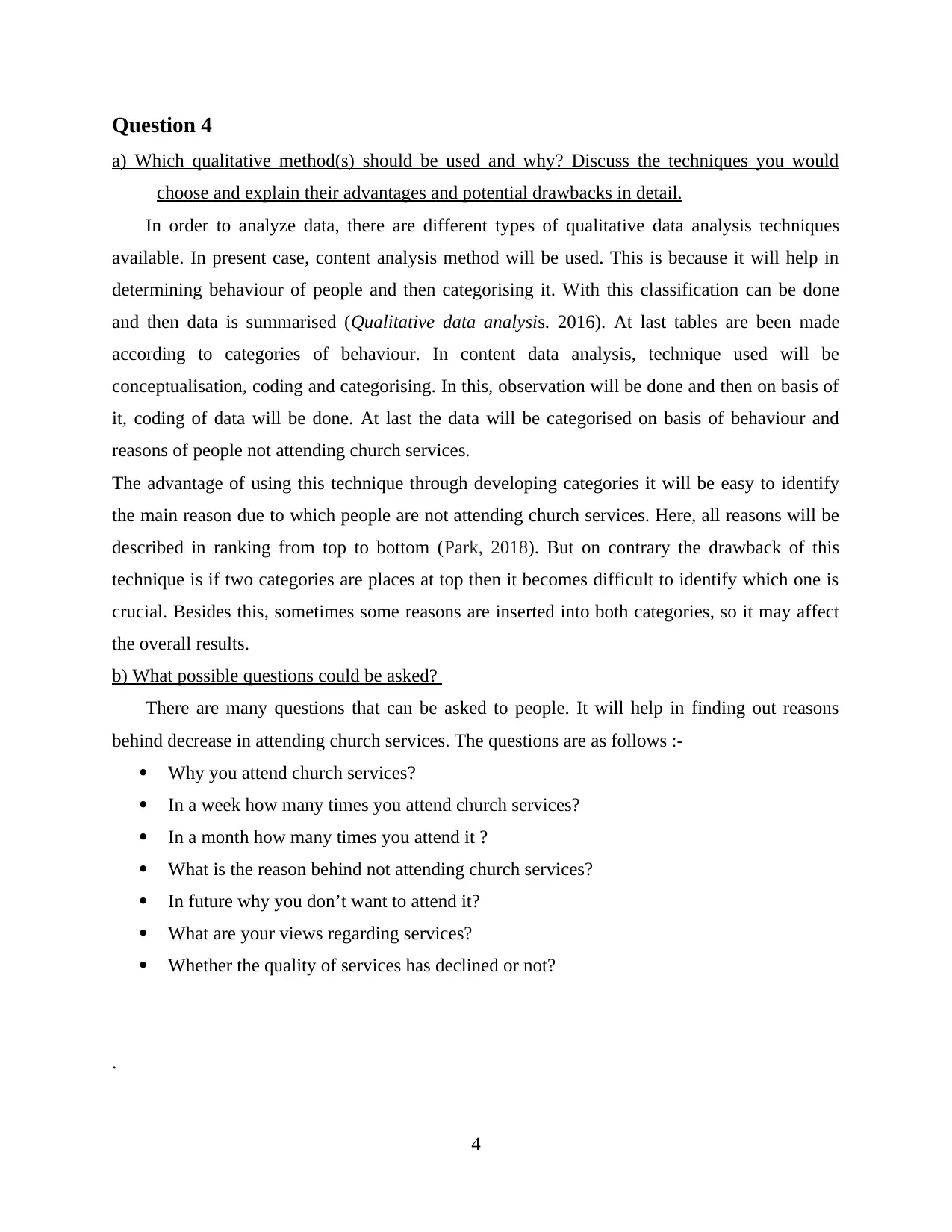
Question 4
a) Which qualitative method(s) should be used and why? Discuss the techniques you would
choose and explain their advantages and potential drawbacks in detail.
In order to analyze data, there are different types of qualitative data analysis techniques
available. In present case, content analysis method will be used. This is because it will help in
determining behaviour of people and then categorising it. With this classification can be done
and then data is summarised (Qualitative data analysis. 2016). At last tables are been made
according to categories of behaviour. In content data analysis, technique used will be
conceptualisation, coding and categorising. In this, observation will be done and then on basis of
it, coding of data will be done. At last the data will be categorised on basis of behaviour and
reasons of people not attending church services.
The advantage of using this technique through developing categories it will be easy to identify
the main reason due to which people are not attending church services. Here, all reasons will be
described in ranking from top to bottom (Park, 2018). But on contrary the drawback of this
technique is if two categories are places at top then it becomes difficult to identify which one is
crucial. Besides this, sometimes some reasons are inserted into both categories, so it may affect
the overall results.
b) What possible questions could be asked?
There are many questions that can be asked to people. It will help in finding out reasons
behind decrease in attending church services. The questions are as follows :-
Why you attend church services?
In a week how many times you attend church services?
In a month how many times you attend it ?
What is the reason behind not attending church services?
In future why you don’t want to attend it?
What are your views regarding services?
Whether the quality of services has declined or not?
.
4
a) Which qualitative method(s) should be used and why? Discuss the techniques you would
choose and explain their advantages and potential drawbacks in detail.
In order to analyze data, there are different types of qualitative data analysis techniques
available. In present case, content analysis method will be used. This is because it will help in
determining behaviour of people and then categorising it. With this classification can be done
and then data is summarised (Qualitative data analysis. 2016). At last tables are been made
according to categories of behaviour. In content data analysis, technique used will be
conceptualisation, coding and categorising. In this, observation will be done and then on basis of
it, coding of data will be done. At last the data will be categorised on basis of behaviour and
reasons of people not attending church services.
The advantage of using this technique through developing categories it will be easy to identify
the main reason due to which people are not attending church services. Here, all reasons will be
described in ranking from top to bottom (Park, 2018). But on contrary the drawback of this
technique is if two categories are places at top then it becomes difficult to identify which one is
crucial. Besides this, sometimes some reasons are inserted into both categories, so it may affect
the overall results.
b) What possible questions could be asked?
There are many questions that can be asked to people. It will help in finding out reasons
behind decrease in attending church services. The questions are as follows :-
Why you attend church services?
In a week how many times you attend church services?
In a month how many times you attend it ?
What is the reason behind not attending church services?
In future why you don’t want to attend it?
What are your views regarding services?
Whether the quality of services has declined or not?
.
4
⊘ This is a preview!⊘
Do you want full access?
Subscribe today to unlock all pages.

Trusted by 1+ million students worldwide

5
1 out of 7
Related Documents
Your All-in-One AI-Powered Toolkit for Academic Success.
+13062052269
info@desklib.com
Available 24*7 on WhatsApp / Email
![[object Object]](/_next/static/media/star-bottom.7253800d.svg)
Unlock your academic potential
Copyright © 2020–2025 A2Z Services. All Rights Reserved. Developed and managed by ZUCOL.





